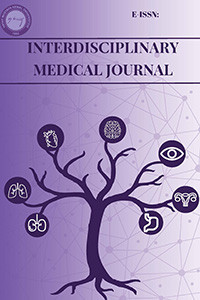Testiküler Seminomatöz ve Nonseminomatöz Germ Hücreli Tümörler: Klinik ve Patolojik Özelliklerinin Karşılaştırılması
Testis Kanseri, Germ Hücreli Tümör, Seminom, Non-Seminomatöz Germ Hücreli Tümör
Testicular Seminomatous and Nonseminomatous Germ Cell Tumors: Clinical and Pathological Features
___
- Chakrabarti PR, Dosi S, Varma A, Kiyawat P, Khare G, Matreja S. Histopathological trends of testicular neoplasm: An experience over a decade in a tertiary care centre in the Malwa belt of central India. Journal of clinical and diagnostic research. 2016;10(6):16-18. https://doi.org/10.7860/JCDR/2016/18238.8025.
- Anjanappa M, Kumar A, Mathews S, Joseph J, Jagathnathkrishna KM, James FV. Testicular seminoma: Are clinical features and treatment outcomes any different in India?. Indian journal of cancer. 2017;54(1):385-387. https://doi.org/10.4103/ijc.IJC_100_17.
- Zhang T, Ji L, Liu B, Guan W, Liu Q, Gao Y. Testicular germ cell tumors: a clinicopathological and immunohistochemical analysis of 145 cases. International Journal of Clinical and Experimental Pathology. 2018;11(9):4622-4629.
- Li Y, Lu Q, Wang Y, Ma S. Racial differences in testicular cancer in the United States: descriptive epidemiology. BMC cancer. 2020;20(1):284 https://doi.org/ 10.1186/s12885-020-06789-2.
- Hassanipour S, Ghorbani M, Derakhshan M, Fouladseresht H, Mohseni S, Abdzadeh E, et al. The incidence of testicular cancer in Iran from 1996 to 2017: A systematic review and meta-analysis. Advances in Human Biology. 2019; 9(1):16-20 https://doi.org/10.4103/AIHB.AIHB_66_18.
- Sarıcı H, Telli O, Eroğlu M. Bilateral testicular germ cell tumors. Turkish journal of urology. 2013;39(4):249-252. https://doi.org/10.5152/tud.2013.062.
- Ulbright TM, Amin MB, Balzer B, Moch H, Humphrey P, Ulbright T, Reuter, editors. WHO classification of tumours of the urinary system and male genital organs. (4th). IARC Press. (Lyon). 2016.
- Sarier M, Tunc M, Ozel E, Duman I, Kaya S, Hoscan MB, et al. Evaluation of histopathologic results of testicular tumors in Antalya: multi center study. 2020;19:64-67. https://doi.org/10.4274/uob.galenos.2019.1412.
- Gill MS, Shah SH, Soomro IN, Kayani N, Hasan SH. Morphological pattern of testicular tumors. Journal of Pakistan medical association. 2020; 50(4):110-113.
- Trabert B, Chen J, Devesa SS, Bray F, McGlynn KA. International patterns and trends in testicular cancer incidence, overall and by histologic subtype, 1973–2007. Andrology. 2015;3(1):4-12. https://doi.org/10.1111/andr.293.
- Lobo J, Costa AL, Vilela-Salgueiro B, Rodrigues A, Guimaraes R, Cantante M, et al. Testicular germ cell tumors: Revisiting a series in light of the new WHO classification and AJCC staging systems, focusing on challenges for pathologists. Human Pathology. 2018;82:113-124. https://doi.org/10.1016/j.humpath.2018.07.016.
- Purdue MP, Devesa SS, Sigurdson AJ, McGlynn KA. International patterns and trends in testis cancer incidence. International Journal of Cancer. 2005;115(5):822-827 https://doi.org/10.1002/ijc.20931.
- Iqbal J, Kehar SI, Jaffer N, Asad F. Frequency and morphological study of testicular germ cell tumor. The Professional Medical Journal. 2019;26(10):1794-1798. https://doi.org/10.29309/TPMJ/2019.26.10.4144.
- Cheng L, Albers P, Berney DM, Feldman DR, Daugaard G, Gilligan T, et al. Testicular cancer. Nature Reviews: Disease Primers. 2018;4(1):29. https://doi.org/10.1038/s41572-018-0029-0.
- Williamson SR, Delahunt B, Magi-Galluzzi C, Algaba F, Egevad L, Ulbright TM, et al. The World Health Organization 2016 classification of testicular germ cell tumours: a review and update from the International Society of Urological Pathology Testis Consultation Panel. Histopathology. 2017;70(3):335-346. https://doi.org/10.1111/his.13102.
- Ozgun A, Karagoz B, Tuncel T, Emirzeoglu L, Celik S, Bilgi O. Clinicopathological features and survival of young Turkish patients with testicular germ cell tumors. Asian Pacific Journal of Cancer Prevention,. 2013;14(11):6889-6892 https://doi.org/10.7314/apjcp.2013.14.11.688.
- Tan G, Azrif M, Shamsul AS, Ho CCK, Praveen S, Goh EH, et al. Clinicopathological Features and Survival of Testicular Tumours in a Southeast Asian University Hospital: A Ten-year. Asian Pacific Journal of Cancer Prevention. 2011;12(10): 2727-2730.
- Izegbu MC, Ojo MO, Shittu LA. Clinico-pathological patterns of testicular malignancies in Ilorin, Nigeria-a report of 8 cases. Journal of Cancer research and therapeutics. 2005;1(4):229-231. https://doi.org/10.4103/0973-1482.19598.
- O’Sullivan B, Brierley J, Byrd D, Bosman F, Kehoe S, Kossary C, et al. The TNM classification of malignant tumours-towards common understanding and reasonable expectations. Lancet Oncol. 2017;18(7):849-851 https://doi.org/10.1016/S1470-2045(17)30438-2.
- Angulo JC, Gonzalez J, Rodriguez N, Núñez C, Rodríguez-Barbero JM, Santana A, et al. Clinicopathological study of regressed testicular tumors (apparent extragonadal germ cell neoplasms). J Urol 2009;182(5):2303-2310 https://doi.org/10.1016/j.juro.2009.07.045.
- Gilligan TD, Seidenfeld J, Basch EM, Einhorn LH, Fancher T, Smith DC, et al. American Society of Clinical Oncology Clinical Practice Guideline on uses of serum tumor markers in adult males with germ cell tumors. J Clin Oncol. 2010;28(20):3388-3404 https://doi.org/10.1200/JCO.2009.26.4481.
- Stenman UH, Alfthan H, Hotakainen K. Human chorionic gonadotropin in cancer. Clin Biochem. 2004;37(7):549-561. https://doi.org/10.1016/j.clinbiochem.2004.05.008.
- Schefer H, Mattmann S, Joss RA. Hereditary persistence of alpha-fetoprotein. Case report and review of the literature. Ann Oncol. 1998;9(6):667-672. https://doi.org/10.1023/a:1008243311122.
- Yayın Aralığı: Yılda 3 Sayı
- Başlangıç: 2023
- Yayıncı: Hatay Mustafa Kemal Üniversitesi Tıp Fakültesi Dekanlığı
Erkek Meme Kanseri: Tek Merkez Deneyimi
Ahmet Cem ESMER, Ahmet DAĞ, Mustafa BERKEŞOĞLU, Deniz TAZEOĞLU
Üst Gastrointestinal Sistemde Yabancı Cisimlerin Değerlendirilmesi: Tanı ve Tedavi
Hasan ÇANTAY, Turgut ANUK, Barlas SÜLÜ, Kenan BİNNETOĞLU, Tülay ALLAHVERDİ, Doğan GÖNÜLLÜ
Covid-19'da Tıbbi Tedavi: Tedavi Sonrası Laboratuvar Sonuçlarında ve BT Bulgularında Değişiklikler
Romatoid Artritli Hastaların Perspektifinden Yaşam Deneyimleri: Fenomenolojik Bir Yaklaşım
Hülya DURAN, Nihan CEKEN, Bülent ATİK
Orak Hücre Anemili Hastalarda Osteoporoz ile İlişkili Biyokimyasal Markerlerin Tanıdaki Yeri
Meryem KORKMAZ, Berna KUŞ, Emre DİRİCAN, Abdullah ARPACI
İbrahim DUMAN, Serkan DAVUL, Hasan HALLAÇELİ, Yunus DOĞRAMACI, Vedat URUÇ
COVID-19 Pnömonisi ve Akut Böbrek Hasarı: Hemodiyaliz Tedavisi
